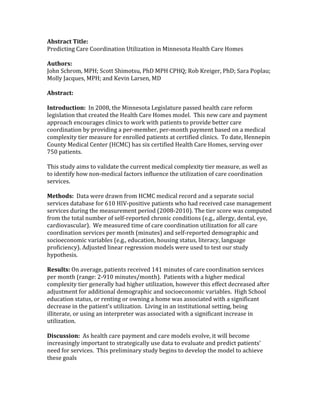Recommended
Recommended
January RML Rendezvous - Health Information Literacy

RML Rendezvous - Health Information LiteracyNational Network of Libraries of Medicine, Pacific Northwest Region
More Related Content
What's hot
January RML Rendezvous - Health Information Literacy

RML Rendezvous - Health Information LiteracyNational Network of Libraries of Medicine, Pacific Northwest Region
What's hot (20)
The Patient-Centered Medical Home in the Transformation From Healthcare to He...

The Patient-Centered Medical Home in the Transformation From Healthcare to He...
Good Food Supplements Reduce Hospitals Re-admission rate

Good Food Supplements Reduce Hospitals Re-admission rate
National Conference on Health and Domestic Violence. Plenary talk 

National Conference on Health and Domestic Violence. Plenary talk
UTILIZING CARE MANAGEMENT NURSES TO IMPROVE TRANSITIONS IN CARE IN THE OUTPA...

UTILIZING CARE MANAGEMENT NURSES TO IMPROVE TRANSITIONS IN CARE IN THE OUTPA...
Similar to Abstract
Presentation by Annette Gardner PhD, MPH
Assistant Professor, Department of Social and Behavioral Sciences,
and the Philip R. Lee Institute for Health Policy Studies, UCSF
Treating The Whole Person: Strategies for Integrating Care. Workshop for Physicians,
Mental Health Providers, ER nurses, Psychiatric Nurses, and Students Mental Health/Primary Care Integration: Lessons from Five Counties

Mental Health/Primary Care Integration: Lessons from Five CountiesPhilip R. Lee Institute for Health Policy Studies
Similar to Abstract (20)
Evaluating the Effectiveness of Communityand Hospital Medica

Evaluating the Effectiveness of Communityand Hospital Medica
Why Electronic Health Records are Ill Suited for Population Health

Why Electronic Health Records are Ill Suited for Population Health
Why Electronic Health Records are Ill Suited for Population Health 012616

Why Electronic Health Records are Ill Suited for Population Health 012616
PHM Tools and Strategies to Support Care Coordination 

PHM Tools and Strategies to Support Care Coordination
AugustSeptember 2011 Issue◂ Previous Article (publicatio.docx

AugustSeptember 2011 Issue◂ Previous Article (publicatio.docx
Payment Reform for Primary Care – Minnesota DHS efforts

Payment Reform for Primary Care – Minnesota DHS efforts
Improving Patients’ Health Before, During, and After an Acute Care Visit

Improving Patients’ Health Before, During, and After an Acute Care Visit
Mental Health/Primary Care Integration: Lessons from Five Counties

Mental Health/Primary Care Integration: Lessons from Five Counties
121016 understanding patterns_of_health_and_social_care_at_the_end_of_life_su...

121016 understanding patterns_of_health_and_social_care_at_the_end_of_life_su...
More from John Schrom
More from John Schrom (7)
Abstract
- 1. Abstract Title: Predicting Care Coordination Utilization in Minnesota Health Care Homes Authors: John Schrom, MPH; Scott Shimotsu, PhD MPH CPHQ; Rob Kreiger, PhD; Sara Poplau; Molly Jacques, MPH; and Kevin Larsen, MD Abstract: Introduction: In 2008, the Minnesota Legislature passed health care reform legislation that created the Health Care Homes model. This new care and payment approach encourages clinics to work with patients to provide better care coordination by providing a per-‐member, per-‐month payment based on a medical complexity tier measure for enrolled patients at certified clinics. To date, Hennepin County Medical Center (HCMC) has six certified Health Care Homes, serving over 750 patients. This study aims to validate the current medical complexity tier measure, as well as to identify how non-‐medical factors influence the utilization of care coordination services. Methods: Data were drawn from HCMC medical record and a separate social services database for 610 HIV-‐positive patients who had received case management services during the measurement period (2008-‐2010). The tier score was computed from the total number of self-‐reported chronic conditions (e.g., allergy, dental, eye, cardiovascular). We measured time of care coordination utilization for all care coordination services per month (minutes) and self-‐reported demographic and socioeconomic variables (e.g., education, housing status, literacy, language proficiency). Adjusted linear regression models were used to test our study hypothesis. Results: On average, patients received 141 minutes of care coordination services per month (range: 2-‐910 minutes/month). Patients with a higher medical complexity tier generally had higher utilization, however this effect decreased after adjustment for additional demographic and socioeconomic variables. High School education status, or renting or owning a home was associated with a significant decrease in the patient’s utilization. Living in an institutional setting, being illiterate, or using an interpreter was associated with a significant increase in utilization. Discussion: As health care payment and care models evolve, it will become increasingly important to strategically use data to evaluate and predict patients’ need for services. This preliminary study begins to develop the model to achieve these goals
